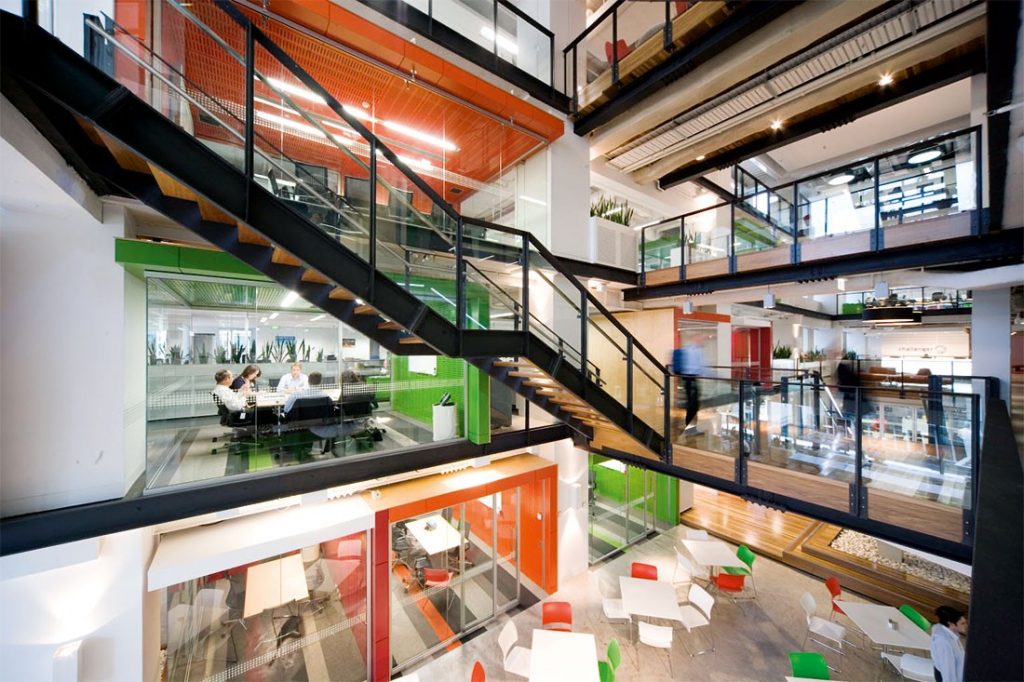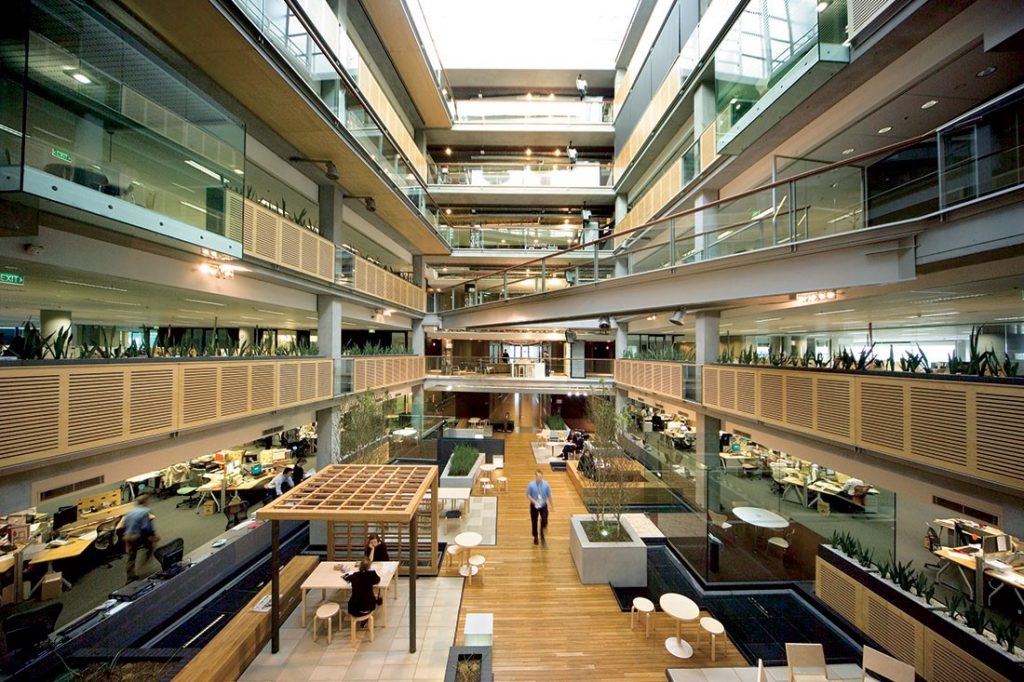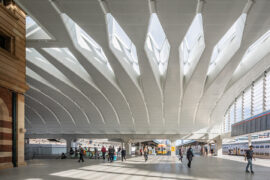Rosemary Kirkby has been described by an industry commentator as “a fearless, well-organised dynamo of a campaigner for better workplace design.” Kirkby has created internationally acclaimed and award-winning workplaces, which have revolutionised the thinking about work and workplaces and set completely new benchmarks.
January 16th, 2018
Technology is changing the world today as radically as the industrial revolution transformed society in the 19th century. Its impact is particularly evident in the way we work and in the design of the 21st century workplace, and as it happens, Australia is at the forefront of that change. Two local workplace projects have been seminal – Campus MLC in North Sydney (2001) and the National@Docklands building in Melbourne (2004) – and these ground-breaking achievements would never have come about as they did without the driving force behind them, project director and change strategist, Rosemary Kirkby. Described by an industry commentator as “a fearless, well-organised dynamo of a campaigner for better workplace design.” Kirkby created these internationally acclaimed and award-winning workplaces together with architect, James Grose from Bligh Voller Nield (BVN). They are projects which have revolutionised thinking about work and workplaces and created completely new benchmarks.

GPT Sydney.
A term commonly used to describe the changes going on in the workplace is Activity Based Working (ABW) – a process which responds to the fact that mobile technology has now freed people from their desks. It is an idea that has been so widely adopted by leading institutions, Kirkby feels it’s almost regarded as a product to be installed off the rack. If only it were that simple.
While she embraces the technology that makes AWB possible, she approaches the design of the workplace from the other end of the stick – from the human perspective. Through her determination to involve all parties including employees in the design, and her insistence on collaboration and innovation as the basis for an organic, co-operative process, Kirkby has taken a pioneering role, often against entrenched resistance. (What was a human resources person doing taking on the role of a property manager?) But she credits this process of inclusion, together with good governance, with the success of her projects and the results – a far cry from the standard call for new desks and chairs – have demonstrated the potential of good design to boost productivity, drive cultural change and promote business development.
Despite the challenges, Kirkby has found herself on a hugely rewarding personal journey. Over the last 15 years she has gathered significant expertise in a complex specialist area that marries business, technology and design acumen with behavioural and leadership development skills. She has also created a new position for herself in architecture, a discipline that both delights and inspires her. It is not a place Kirkby had anticipated finding herself at this point in her career, although it is easy to see her upbringing and prior working life pointing her in this direction.
Raised in an old farming family on the north-west plains of NSW, Kirkby developed a feeling for space and, through the beauty and economy of woolsheds, homesteads and farm buildings, an appreciation for built form. She acquired a great respect for people and for the different contributions they could make to the small outback community, particularly in times of crisis. She was also brought up with the notion that, as someone who is “quite privileged by comparison, you have an obligation to put something back.” It was a life that bred a sure character and a certain resilience. She says, “Growing up in Moree gave me this strong feeling about the need for human beings to share a sense of community, of shared destiny.”

National@Docklands by BVN, which Rosemary Kirkby collaborated on. Photo by John Gollings.
After boarding school in Sydney, a Bachelor of Arts from Sydney University, travelling and teaching for a few years and acquiring some supercharged secretarial skills, in 1976 Kirkby had the good fortune, she says, to be hired by Stuart Hornery, who was then head of Civil and Civic, part of the Lend Lease Group. “I became a student of Lend Lease’s culture, which was quite remarkable,” she says. “There was a set of disciplines – project management was at its core and you were expected to get results – but it was a very inclusive culture, and the rules were the same for everyone, whether it was someone parking the car or the chief executive. Elements were very familiar from my background and I felt very comfortable in it,” she says. Hornery quickly became one of Kirkby’s great mentors. She credits him with teaching her to think, and she remained at Lend Lease for the next 24 years taking on numerous roles in marketing, project management, organisational behaviour and leadership development. As Kirkby says, “Despite being a woman, I never had to leave Lend Lease in order to find the next challenge or the next opportunity.”
And opportunity arose sharply. When Lend Lease bought the 100-year-old Life Assurance firm, MLC, in 1992, Kirkby, who was initially sent over to manage a cultural change program, was subsequently offered the role of project manager of the refurbishment of the 1957 MLC building in North Sydney, which was underway but had faltered. Kirkby suspected the design process offered the potential to promote the cultural change MLC needed, and despite not having experience in architectural work she approached it as she would any other project, according to Lend Lease disciplines and processes.

Challenger, photo by John Gollings.
A detailed technical brief had already been written and plans finalised, but these in no way related to Kirkby’s much larger view of the workplace and how it should be for the people who work in it. “I wanted to give people a chance to design the company they’d never leave,” she says. So she wrote a document called ‘Imagine,’ which begins: “Imagine…working with an organisation where your ability to influence the future of the organisation is limited only by your own imagination.” She goes on to describe a workplace based on freedom and trust, innovation and communication; a place that acknowledges home-life obligations as much as community, camaraderie and the need for time out. Under Kirkby’s guidance, and with support from the new CEO, Peter Scott, the unimpressed project control group was disbanded and the plans scrapped.
Working with Lend Lease project manager, Debbie Berkhout, Kirkby began the whole process again. She looked at current workplaces, both here and overseas. She knew, not least from her own children, that in order to attract and inspire the talented young employees of the future the workplace needed to change radically, to open up and free up and relate more to life. Kirkby conceived of the workplace as a medium-density housing project, where different neighbourhoods were gathered around shared facilities, and she was convinced that the project required “robust architecture on the inside of the building” instead of interior design. Following this line of thinking, Kirkby eventually found James Grose and Bill Dowzer and their team at BVN, who worked on the design of MLC together with workplace specialist, James Calder of DEGW.
“I was really lucky that James Grose came into my life when he did,” says Kirkby, because “he was open to thinking differently. We went right back to first principles and involved the people who were working [at MLC] in the design itself. “It takes a special architect to work that way, because it’s sharing power,” she says, but “I feel really strongly about people being engaged in designing their own futures.” Contrary to standard practice, Kirkby’s multi-disciplinary project team worked with consultants and contractors selected for their willingness to collaborate, and the round-table rule of open discussion, problem-solving and decision-making led to genuine innovation in the built form.
Campus MLC was created – its 12 floors opened up and unified by a central stairway to encourage social interaction. Open planning and workstations were integrated and energised by colour, design and whimsical ideas. There were big shared tables, places to eat and drink, and landmark features such as the zen den, beach, studio and town square, and the refurbished 22,000 square metre workplace ended up accommodating twice the number of staff it had previously. Campus MLC won the RAIA National Interior Architecture award in 2002 and was described by leading Australian architectural academic, Dr Phillip Goad, as representing “one of the most profound shifts in the history of post-War Australian office design.” The real compliment for Kirkby is that, a dozen years later, the recent interior update by Woods Bagot has “preserved the architectural bones” of her scheme. “The desk size has changed, because technology has changed,” she says “but somehow we got the design right. What we designed for was universal human behaviour, and we know that’s enduring.”

National@Docklands by BVN.
From 2000 to 2004, Kirkby and Grose went on to consult on MLC/National workplaces in Adelaide, Brisbane, Jakarta, London and Hong Kong, advising local teams on the inclusive design delivery process. Then, when MLC was acquired by the National Bank, they embarked on National@Docklands, a project that escalated into the creation of an all-new 59,000 square metre building to accommodate 3,500 employees. Kirkby managed the project, in conjunction with Peter Affleck from NAB, integrating the interests of the participating stakeholders: the owner GPT, the developer Lend Lease, consultants, contractors, local government and community, and the 60-strong NAB team. It was the largest project ever completed for a commercial tenant in Australia at the time, and surely a feat of management.
As at Campus MLC, there were no offices and few walls, allowing openness and connection both horizontally and vertically. With its low profile, vibrant colour and transparency, and with flexibility and sustainability as important features, the building was designed as a powerful symbol of the cultural change going on within it as much as a facilitator for it. While Kirkby believes “the workplace should be more like theatre or exhibition space than anything else,” she was concerned during the building that the sheer scale of all the steel and glass might overwhelm the sense of humanity she was wanting, but when the scaffolding in the vast atrium was removed she was almost moved to tears, she says, by “the uplifting feeling of space.” National@Docklands attracted continuing acclaim for Kirkby and Grose, and more awards for interior design, for a commercial building and for sustainability. Both Campus MLC and National@Docklands remain powerful symbols of what can be achieved.
On the completion of National@Docklands, Kirkby established her own consultancy, working on projects that married workplace design with corporate and cultural objectives, including relocations and fit-out projects for Bluestone Mortgages, Stockland, Pfizer, the University of Melbourne, Monash University Law School and the University of Adelaide. A project she managed for Challenger Financial Services won an AIA NSW Interior Architecture award, and after joining the GPT leadership team as Head of Change and Sustainability in 2010, GPT’s new premises were also shortlisted for an interior award.
In addition to these roles, Kirkby has also been appointed to various government committees and enquiries over the years. She has been made a Principal Fellow in the Faculty of Architecture, Building and Planning at the University of Melbourne, and in 2008 was nominated Corenet Global Real Estate Executive of the Year for Australia and New Zealand for her contribution to workplace design.
Having recently resumed her consultancy work, Kirkby appreciates the unique position she has created for herself. “The last ten years have been very good to me,” she says. “Finding the design community was wonderful.”

National@Docklands by BVN. Photo by John Gollings.
She defines workplace as the interplay of people, process and place, and sees herself, as one of the more experienced people in large-scale organisational cultural change in Australia, as that of a bridge, bringing different interests and talents together. “Essentially the only thing that’s changed is technology,” says Kirkby. “The basic things you still need to do for people – giving them meaningful work, creating learning environments and letting them work to their full potential – are absolutely fundamental.”
“Let’s look at people and what drives productivity,” she says. Efficiency is only one measure, the other side is, how do you get people to give you voluntarily everything they’ve got to give you. I think that’s about nurturing… I learnt that from Stuart Hornery. You’re tough on performance, but soft on people…I think everyone should jump out of bed wanting to go to work every day. I’m always amazed when people say you’re so lucky you enjoy what you do – I think everyone should love what they do!”
Rosemary Kirkby was featured as an Indesign Luminary in issue 54 of Indesign.
INDESIGN is on instagram
Follow @indesignlive
A searchable and comprehensive guide for specifying leading products and their suppliers
Keep up to date with the latest and greatest from our industry BFF's!

The undeniable thread connecting Herman Miller and Knoll’s design legacies across the decades now finds its profound physical embodiment at MillerKnoll’s new Design Yard Archives.

CDK Stone’s Natasha Stengos takes us through its Alexandria Selection Centre, where stone choice becomes a sensory experience – from curated spaces, crafted details and a colour-organised selection floor.

For Aidan Mawhinney, the secret ingredient to Living Edge’s success “comes down to people, product and place.” As the brand celebrates a significant 25-year milestone, it’s that commitment to authentic, sustainable design – and the people behind it all – that continues to anchor its legacy.

London-based design duo Raw Edges have joined forces with Established & Sons and Tongue & Groove to introduce Wall to Wall – a hand-stained, “living collection” that transforms parquet flooring into a canvas of colour, pattern, and possibility.

The World Architecture Festival has named The Holy Redeemer Church and Community Centre of Las Chumberas in La Laguna, Spain as World Building of the Year 2025, alongside major winners in interiors, future projects and landscape.

Architects Declare and Suppliers Declare are uniting with the aim of making transparent, responsible specification the new industry standard.

The Australian Institute of Architects has unveiled 43 projects representing the pinnacle of contemporary design, with winners addressing housing, climate and affordability crises through innovative solutions.

BVN’s Sirius Redevelopment has been named one of two joint winners of The Building category at the INDE.Awards 2025. Celebrated alongside Central Station by Woods Bagot and John McAslan + Partners, the project reimagines an iconic Brutalist landmark through a design approach that retains heritage while creating a vibrant, sustainable future for Sydney.
The internet never sleeps! Here's the stuff you might have missed

In contemporary interiors, ensuring a sense of comfort and wellbeing means designing and specifying finishes and products that support all the senses.

From the spark of an idea on the page to the launch of new pieces in a showroom is a journey every aspiring industrial and furnishing designer imagines making.